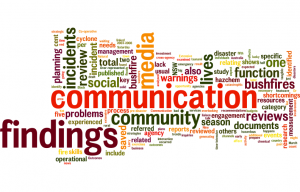We’re at the tail end of the disaster season in Australia, with the Queensland bushfire season extended  by four months past its usual end, Victoria and NSW working fire business as usual and cyclone watchers waiting for the big one, which could still happen in the next few weeks.
by four months past its usual end, Victoria and NSW working fire business as usual and cyclone watchers waiting for the big one, which could still happen in the next few weeks.
More than ever, community involvement in disaster management is necessary.
Yet my new research shows that more than one fifth of the problems experienced during disasters in this country related to shortcomings in communication with the community. Despite this, less than one per cent of most agency operational budgets are allocated to the communication and community engagement functions.
This one per cent has certainly saved lives already this season – the February heatwave saw catastrophic bushfires in NSW with the town of Uarbry burnt to the ground and others experiencing extensive damage – but no lives lost.
But we won’t always be this lucky. So where is it going wrong?
I reviewed 22 reviews, inquiries and debriefing documents of events and exercises that occurred between 2009 and 2016, including the Black Saturday bushfires. The documents covered bushfires (17), floods (3) and hazardous chemical incidents (2).
I analysed 672 recommendations and findings from these reports and found that 20.4%, or 137, concerned community communication shortcomings during the incident. I did not include agency or cross-agency communication in this count.
This was up 1.3% from a similar study of 2003-2008 reports that was published 2009 with Dr Amalia Matheson. I’ll talk more later about why this might be.
Top of the list was education and pre-disaster engagement, which reflects the bushfire focus of the documents I reviewed. They made up 39 of the 137 findings.
This also happens to be the most time consuming function of communication teams, and lack of resources will affect this activity the most. Extensive Bushfire and Natural Hazards Co-operative Research Centre research shows exactly what needs to be done and what dialogue needs to be established to prepare communities and individuals for bushfire, cyclone, tsunami, earthquake and flooding. We have the opportunity to be effective in this area with just a small amount of additional investment on what currently occurs. Benefits of doing this are tangible.
Next culprit was communication planning, which included strategic planning for incidents where communication had been overlooked – 21 (or 15.3%) of the findings dealt with this. This is another time-intensive function, but it has no tangible result – it can’t be linked to the outcomes in a specific incident, and only measurement of trends over years can provide solid proof of its effect.
Warnings attracted 20 findings (14.6% of the total), which was most concerning, because the warnings phase of response is where most lives are saved. Over-represented in the warnings findings were hazchem incidents, with two incidents examined generating five of the 20 findings relating to warnings. Reading further into the review of each incident, this seemed to be a result of hazchem events falling outside the experience and operational guidelines of metro and rural fire services. In some incidents, warnings were received by unofficial means before the official version arrived.
Interaction with the media was also problematic, with 17 findings (12.4%). These included delays in moving media materials through head office for sign off in fast moving incidents, where any delay can see a media release or information points out of date before it is released; the importance of having media in state operation centres to speed up broadcast of critical information; and consistency of facts given across all media.
Resourcing of the communication function was specifically identified in five findings (3.6%), but also fingered as a contributor to findings relating to lack of communication engagement plans, overlooking specific communication channels (such as social media), media liaison skills, media planning, and messaging skills.
However, the news is not all bad. Nine of the 137 findings referred to social media (7%), causing an increase in the total findings on 2010. Seven of these related to incidents in 2011, the other two from the Tasmania bushfires review of 2013. None of the 13 later reviews, published from 2013 to early 2016, referred to social media, indicating that agencies have improved social media strategies and resourcing.
In the 2010 study, half of the 12 reviews considered did not include community feedback in the review process. Of the 22 reviews studied here, 77% used this technique to identify problems for the review process. With communication being the key link between operations and the community, it would be expected that more findings relating to this aspect of emergency management might emerge.
Overall, communication is a critical component of emergency management that seems not to have the higher level commitment that it should – after all, appointing a new communicator or funding a preparedness campaign is not as tangible or promotable as a new fire truck.
Barbara Ryan is a disaster communication researcher at the University of Southern Queensland in Toowoomba, Queensland, Australia and teaches crisis and disaster communications in the Graduate Certificate of Business.
Save
Save
Save
Save
Save
Save
Save



 by four months past its usual end, Victoria and NSW working fire business as usual and cyclone watchers waiting for the big one, which could still happen in the next few weeks.
by four months past its usual end, Victoria and NSW working fire business as usual and cyclone watchers waiting for the big one, which could still happen in the next few weeks.